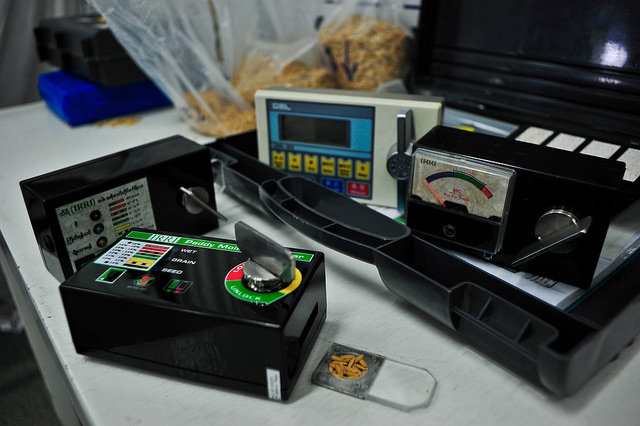Using moisture meters
Many different makes of portable grain moisture meters are available. Some work on change in resistance and others work on change in capacitance. When selecting a meter, make sure it is suitable for paddy and polished rice and other crops being grown. The price of commercial meters ranges from USD 250 to 750. Before using a meter, consult the manual to find out the correct procedure for measurement.
IRRI moisture meter
 The IRRI low-cost moisture meter is a decision making tool for postharvest operations that costs half of the price of a more advanced moisture tester, and is not intended for trade.
The IRRI low-cost moisture meter is a decision making tool for postharvest operations that costs half of the price of a more advanced moisture tester, and is not intended for trade.
Fact sheet: Mark III - IRRI Moisture Meter
Resistance-type moisture meters
Quick moisture testers are most suitable for use in the field and for trade because they give a very fast result and they are reasonably accurate within a 1% range.
Although the resistance type moisture meters are not too expensive, farmers still can not afford them.
To operate a quick moisture meter follow the basic steps outlined below. This is the procedure for using the Kett Rice Tester.
Guidelines for using a resistance type moisture meter:
- Turn on the moisture meter and make sure that button indicating "paddy" is on.
- Fill the tray of the moisture tester with paddy to the required level.
- Turn the knob until the moisture reading is displayed.
- Take measurements of 3−5 samples and compute the average moisture content.
Make sure that you turn the knob all the way as described in the manual. If the knob is not turned far enough you will get a wrong reading.
IRRI does not endorse any particular brand or type of moisture meters. However, it would be wise to make inquiries about different brands as price is not always a good indicator for device quality and accuracy.
For accurate measurements, make sure that you take a representative sample across the field and make at least 3 measurements at each location to get a good average value.










